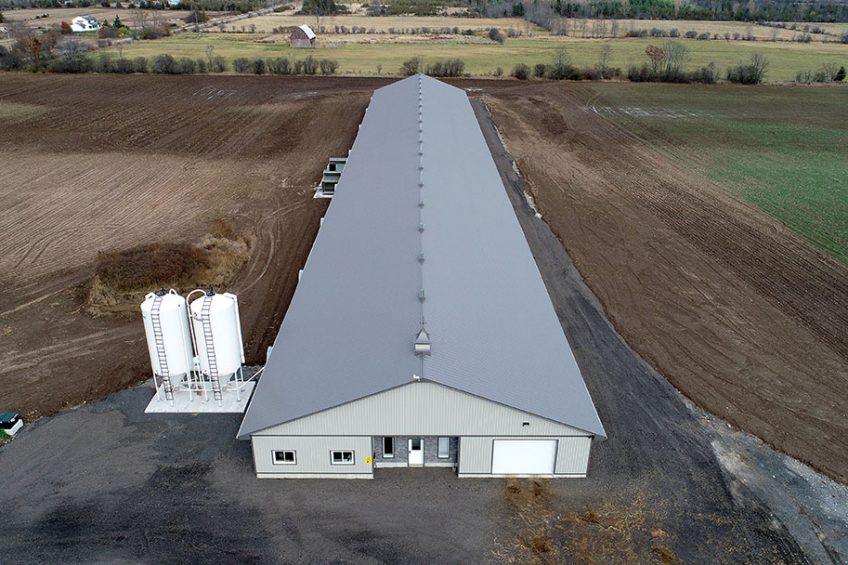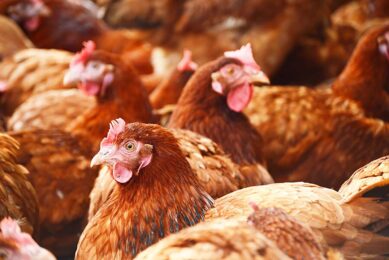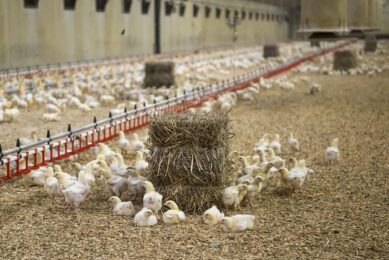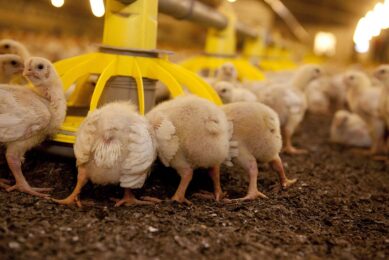Farm report: Producing broilers under quota regulations

Giving broilers a good start in their first 10 days of life is one of the main goals of Prinzen Poultry Farm, Ontario, Canada.
Based in Prince Edward County, Prinzen Poultry Farm produces around half a million chickens per year under regulation to the strict, but fair, supply management quota system they have there. Jeremy Prinzen runs the farm together with his wife Jennifer and their 3 children, after they took it over in 2006. Over the years the Prinzens have modernised some of the chicken houses on the farm and built a new production unit off site.
 PROFILE
PROFILE
Name: Prinzen family
Residence: Prince Edward County (Canada)
Enterprise: The Prinzen farm has 2 locations where 445,000 birds in total are raised per year. Average bird weight at slaughter is about 2.2 kgs.
Jeremy explains how the expansions took shape over the years. “We purchased the farm from my wife’s parents who had owned it since 1989. They purchased the farm from my wife’s grandparents who had bought the farm in 1979. Our home farm had 3 barns, 2 of which had 3 stories, and the other 2 stories. Since April of 2019 we no longer use one of the 3-storey barns.” He continues: “We built a new chicken barn at a different location and moved some of the production there. The barns on the home farm were built in the 1950s and are really showing their age. However, 2 and 3-storey barns are a thing of the past. The industry is moving to all single-storey houses for ease of catching and to increase animal welfare while handling birds.”
Focus on farm management
All the broilers grown at Prinzen Poultry are caught and transported for slaughter by outside contractors leaving Jeremy and Jennifer more time to run the business side of the farm. “At the home farm there are 60 acres and the new location has 104 acres. We raise approximately 245,000 chickens per year at the home farm and approximately 200,000 at the new location,” says Jeremy. “We do not have any outside growers and do not process any of our own birds.” He explains how he tries to focus on farm management as much as possible. “Our processing is all contracted out, which includes the catching of the birds, so the people handling the day-to-day operations are Jennifer and myself. The kids help out as needed. All broilers get shipped live to either Maple Lodge Farms or Maple Leaf Foods.”

Strict routine when preparing houses for new flocks
Jeremy and his family follow a strict routine when it comes to preparing the houses to ensure they are clean and dry for the next flock of chicks. “After the barns are all cleaned and disinfected following the previous flock, it’s time to get ready for the next,” says Jeremy Prinzen. “We use large square bales measuring 3x3x6 feet for bedding which go through a large chopper and we blow the straw into the barns. The next task would be to drop all the feeders and water lines, place feed into the lines and heat the barn to 32° Celsius,” he says.
Constant monitoring of poultry barn
Chicks arrive on the Prinzen farm usually less than 12 hours post hatch. From there placement to the processing stage takes around 33 to 38 days depending on the processor requirements for size. On average the bird weight is around 2.2 kgs. The temperature in the barn at shipping is near 22°C. “We are constantly monitoring the barn environment: checking the temperature, feed availability, water availability, litter quality, bird uniformity, air quality in terms of CO2 and ammonia levels. Adjustments are made as required to airflow,” he explains.
![]() Country reports:
Country reports:
Takes a look at the poultry industry in countries around the world.
Cost of production formula
Like all farmers across the world, a focus on cost and performance is key at Prinzen. “We buy all our feed from either Masterfeeds or Nutreco. I don’t get involved with what they include for ingredients, I just let their nutritionist decide. Feed is near CAN$ 400 (US$ 300) per tonne.” He continues: “Of course feed prices can fluctuate, but our live price has a cost of production formula included. So when feed and chick cost moves in price, our live price follows shortly after.” The live price in Canada is determined by the Ontario Chicken Marketing Board. “When I determine profits, I look at the after feed and chicks profit. That really determines how the flock performed,” says Prinzen. Jeremy notes that most of the other costs, for example gas, power, mortgage and maintenance costs, remain somewhat consistent at his farms, depending on the time of the year.
As with every other poultry farmer he is concerned about avian influenza getting into his flock and takes the necessary precautions to try and prevent it. Prinzen states: “Ontario Chicken Farmers have a stringent bio-security system in place including regulations on disinfection, no outside visitors, changing footwear before entering the barn and no other domestic birds on premises. I have not been affected directly by AI, but we now pay into an AI insurance fund that will help if we have to depopulate for an extended period of time.”
 Objective risk-based scoring of biosecurity
Objective risk-based scoring of biosecurity
Investing in on-farm biosecurity is a no-brainer in the livestock industry, but where to put the extra effort and money in existing schemes is a more difficult question to answer.
For many poultry producers around the world disposing of the manure is a huge challenge but he has a good outlet. “All the manure is shipped to a local mushroom plant that buys it off us by the tonne,” Jeremy explains. “They use the manure in their compost mixture.”

Consistent and profitable production
For Prinzen one of the biggest challenges in the industry is chick quality and giving them a good start. The first 10 days are the most important to ensure consistent and profitable production. “In our cost of production formula, there is a producer margin. That portion has had some serious flaws in it over the past number of years. It is not keeping up with other costs associated with farming. Our board is currently working on re-doing that formula to increase the producer margin so we can increase capital investment,” Jeremy reports. “In Canada we have a supply management system which means we can only produce the number of kilogrammes that our quota specifies. Our production is kept consistent which also keeps our live price consistent. When there is consistency, we can make better decisions with regard to capital investments.” he continues. “One of my biggest strengths is working from home on your own schedule,” Jeremy concludes. “There’s nothing better than that, nothing better than being a farmer.”
Join 31,000+ subscribers
Subscribe to our newsletter to stay updated about all the need-to-know content in the poultry sector, three times a week. Beheer
Beheer








 WP Admin
WP Admin  Bewerk bericht
Bewerk bericht